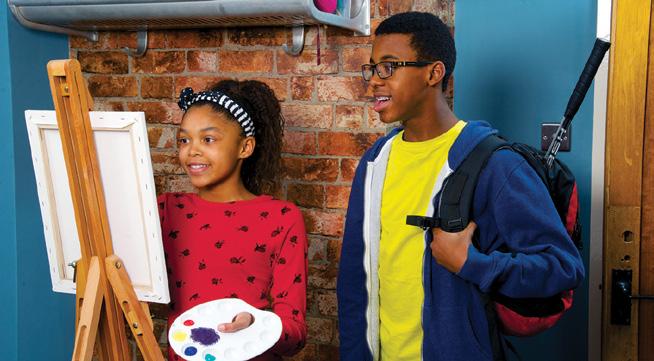


Cambridge University Press 978-1-107-55714-7 – Guess What! American English Level 5
Susannah Reed Excerpt M







Cambridge University Press 978-1-107-55714-7 – Guess What! American English Level 5
Susannah Reed Excerpt M










Cambridge University Press 978-1-107-55714-7 – Guess What! American English Level 5
Susannah Reed Excerpt M

Unit aims Students will talk about their family members and pets. This includes:

• saying what their personalities are like
• comparing themselves and other members of their family with each other
• identifying and discussing their own and other people’s talents
They will also learn how ant families work together. Background information The photograph shows two young captive meerkats in Germany.
Introduction to the unit
• Read the title of the unit and ask students to look at the photograph. Then ask What’s Unit 1 about? Students guess (Family). Congratulate students who guess correctly.
• Ask What can you see in the photograph? Teach the new word meerkat and ask students to think of ways the photograph shows the concept of the family. Accept any ideas, e.g., The meerkats love each other. They are showing affection to each other.
• Point out that meerkats are known for living together in big community groups, which include several families. Ask students to think of the advantages of families living together in a community. (They can help/protect each other. They like seeing each other and being together.)
• Elicit vocabulary for extended family members (parents, grandparents, aunts, uncles, cousins, etc.). Then ask students about their own extended families: Where do they live? How often do you see them? What do you all like doing together? Elicit different activities, e.g., celebrate together, have a barbecue, have a family picnic, have a party, eat together, give presents.
• Ask students if any of them have ever seen meerkats (e.g., in local zoos or wildlife parks). They can then say or guess which continent meerkats are from (Africa). If you have a world map or globe, ask students to find and point to Africa on it.
































































































































































Cambridge University Press 978-1-107-55714-7 – Guess What! American English Level 5
Susannah Reed Excerpt
Lesson aims Students learn and talk about what their family members and pets are like.
New language friendly, kind, sporty, artistic, talkative, hardworking, smart, funny, shy, naughty | What’s (your family) like?
Recycled language Is this (your family)? | Are these (your parents)? | This is / That’s my (aunt). | He’s/She’s/They’re (sporty). | They like/love (playing tennis). | He/She’s good at (volleyball).
Materials CD1
Warmer
• Introduce the topic of families. Say, e.g., I have two sisters. My sisters live in the United Kingdom with my parents. I have lots of cousins, too. Some of my cousins live in the United States. Then ask students, e.g., Do you have brothers and sisters? How many (sisters) do you have? Do you have any cousins? Do you have any pets? Who has a puppy or a kitten?
• Ask individual students What’s your (sister/puppy) like?
Student’s Book page 16
1 Listen and look.
• Say This is Alex’s family. What’s Alex’s family like? Listen and point. Play the recording. Students listen and point to the different members of Alex’s family.
• Highlight the meaning of the new adjectives.
• Then play the recording again, pausing as necessary to ask What’s Alex’s (aunt) like? (She’s (kind).)
CD1:16
Pedro: Is this your family, Alex?
Alex: Yes, it is.
Pedro: Where were you?
Alex: We were at a family party. These are my grandparents. They’re very friendly.
Pedro: And who’s this?
Alex: That’s my aunt. She’s very kind. She always gives me presents.
Pedro: And are these your parents?
Alex: Yes. They’re very sporty. They love playing tennis.
Pedro: And who’s this?
Alex: That’s my uncle. He’s very artistic. He paints a lot.
Pedro: And I know this is your sister.
Alex: Yes – talking again! She’s very talkative. She’s always on the phone. And here’s my brother. He’s very hardworking. He’s always doing his homework.
Pedro: And who’s this?
Alex: My cousin. She’s a scientist, and she’s very smart. And this is my best friend. He’s very funny. We laugh a lot together.
Pedro: Is this your kitten?
Alex: Yes. It’s very shy. It doesn’t like being in photographs.
Pedro: And look! Your new puppy! It looks naughty.
Alex: Well, it’s a little naughty. But it’s only a baby.
Pedro: It’s so cute!
2 Listen and repeat. Then match.
• Play the recording. Students repeat and point.
• Play the recording again. Students match each word to its vocabulary label in the box. They say the letter of each label and then read it aloud.
Key: 1 c 2 f 3 i 4 a 5 j 6 e 7 b 8 d h 10 g
CD1:17
1 friendly 2 kind 3 sporty 4 artistic 5 talkative
6 hardworking 7 smart 8 funny shy 10 naughty
3 Listen and guess who. Then practice with a friend.
• Say Now listen and guess who. Play the recording, pausing after each sentence for students to say the family member or pet. Check by asking, e.g., Who’s friendly?
• Students can then play the same guessing game in pairs. They use the photographs and the speech bubbles to help.
Key: 2 his cousin 3 his puppy 4 his parents 5 his brother 6 his sister 7 his kitten 8 his best friend his uncle 10 his aunt
CD1:18
1 They’re friendly. 2 She’s smart. 3 It’s naughty.
4 They’re very sporty. 5 He’s hardworking. 6 She’s very talkative. 7 It’s shy. 8 He’s very funny. He’s artistic.
10 She’s very kind.
4 What is your family like? Ask and answer.
• Students ask and answer about their own families.
Workbook page 12
1 Read and circle the correct words.
• Students read each description and circle the correct adjective that matches it.
Key: 2 c 3 a 4 a 5 c 6 b 7 a
2 Read and complete the sentences. Then write the names.
• Students read the descriptions and then write a sentence with an adjective that describes each person. They then label the photographs with the correct name.
Key: 2 He’s sporty. 1 3 He’s hardworking. 2 4 She’s kind. 4
My picture dictionary ➔ Go to page 85. Write the new words.
• Students label the pictures.
Key: artistic, smart, friendly, funny, hardworking, kind, naughty, shy, sporty, talkative
Ending the lesson
• Play a game of Guess who! (see page xv), describing students in the class.
Extra activities: see page TB112 (if time)
Cambridge University Press 978-1-107-55714-7 – Guess What! American English Level 5
Susannah Reed Excerpt
Lesson aims Students compare themselves with other members of their family.
New language more (talkative)
Recycled language family, adjectives | I’m/He’s/ She’s (shyer) than (my brother). | Are you / Is he/she (friendlier) than (your friend)? Yes, I am. / No, I’m not. Yes, he/she is. / No, he/she isn’t.
Materials CD1 | Word cards: see page TB103 | A family photograph of yours (optional)
Warmer
• Use the word cards to play What’s missing? (see page xvii).
Presentation
• If you have a family photograph, use this to tell the class how the family member shown compares with you, e.g., This is my little sister. She’s younger than me. She’s funnier and more talkative than me. But I’m more hardworking than her. And I think I’m a little smarter!
Student’s Book page 17
5 Read and listen.
• Ask Who can you see? (A boy and a girl.) Are they cousins? Are they brother and sister? Students guess. Then ask What’s the boy like? What’s the girl like? Who’s talkative/shy/kind? Students guess their personalities from the photograph.
• Say Let’s find out! Read and listen to the poem. Play the recording. Students listen and follow the poem text in their books. They can also guess which of the children in the photograph is the writer of the poem (the boy).
• Check understanding by asking Who’s talkative? (The boy.) Who’s shy? (The girl / his cousin.) Who’s friendly? (The boy.) Who’s kind? (The girl / his cousin.)
• Then say Now listen and repeat. Play the recording again, pausing for students to repeat.
CD1:19 : see Student’s Book page 17
6 Listen and choose the words.
• Say Let’s listen to a poem about these two children! Listen and choose the words. Play the recording. Students listen and point to the correct words each time. Then ask students to read aloud the correct version of the poem.
• Repeat some lines of the poem, but this time making deliberate mistakes about the brother and sister for students to correct, e.g., The brother’s more artistic than the sister. No! The sister’s more artistic than the brother.
Key: more artistic, sportier, more hardworking, smarter
CD1: 20
I’m more artistic than my brother, He’s sportier than me.
And I’m more hardworking than my brother,
But he’s smarter than me.
7 Make questions. Then ask a friend.
• Students use the boxes to make questions about how people compare with each other. Demonstrate the activity first, by choosing an expression from each box and asking a student, e.g., Are you friendlier than your sister? Elicit Yes, I am. / No, I’m not. Then check with the class: Is he/she friendlier than his/her sister? (Yes, he/she is. / No, he/she isn’t.)
• Students can then ask and answer in pairs, using the prompts and the example speech bubbles to help them. They can also see how many additional questions they can make.
8 Go to page 102. Listen and repeat the chant.
• Say Go to page 102. Listen and repeat. Play the recording. Students listen and repeat 0the grammar chant, following the text on page 102. Repeat, with students changing roles, until they are chanting confidently.
• Students can also make their own chant verse, substituting the family words and adjectives with their own choices.
CD1:21 : see Student’s Book page 102
Workbook page 13
3 Look at Lee’s graph. Then circle the correct words.
• Students look at the graph, which shows the number of times a brother and a sister show different kinds of behavior. The behavior of the brother, Lee, is shown in the blue bars in the graph. The behavior of the sister, Jen, is shown in the red bars in the graph.
• Students read and circle the words to make true sentences about Lee, using the information in the chart.
Key: 2 more hardworking 3 more talkative 4 kinder 5 naughtier 6 shyer
4 Look at activity 3. Complete the questions and answers.
• Students complete the questions and answers about the children in activity 3, using the chart to help.
Key: 2 shyer than Yes, I am. 3 more talkative than No, I’m not. 4 kinder than Yes, he is. 5 friendlier than Yes, I am. 6 more hardworking than Yes, he is.
5 Complete the questions and answers. Use the words in the box and your own ideas.
• Students complete the questions comparing themselves with a friend. They then answer the questions.
Ending the lesson
• Students can ask you questions similar to those in Student’s Book activity 7.
Extra activities: see page TB112 (if time)



































My dog is smarter than my cat. My brother is more hardworking than my sister.



I’m more talkative than my cousin, She’s shyer than me. And I’m friendlier than my cousin, But she’s kinder than me.


I’m more artistic/more hardworking than my brother, He’s funnier/sportier than me. And I’m more hardworking/more talkative than my brother, But he’s smarter/kinder than me.









Are you Is your brother Is your sister Is your cousin Is your friend more talkative friendlier more hardworking
artistic than your sister? than you? than your brother? than your cousin? than your friend? Yes, I am! Are you friendlier than your sister?








































Listen again and practice.
Teacher: Who’s taller, Carla – you or Emma?
Emma: I am!
Carla: Hmm. Let’s see … I am!
Teacher: Wow! You’re taller than Emma now!
Emma: But I’m still older than you, Carla!
Teacher: And who’s smarter?
Carla: Oh, I don’t know. We’re both smart!
















Name: Emma
Born: June 2nd, 2005
Height: 1 m, 60 cm
Personality: quiet, but friendly Likes: sports and homework



Who’s older, you or your brother? My brother is Focus!



Name: Alex
Born: April 24th, 2006
Height: 1 m, 52 cm
Personality: loud and funny




















Cambridge University Press 978-1-107-55714-7 – Guess What! American English Level 5
Susannah Reed Excerpt M
Lesson aims Students ask questions to compare themselves and other people with each other. They also practice repeating words with stress on the strongest syllable.
New language height | Who’s taller, you or (Emma)? I am. / Emma is. | Who’s more talkative? Recycled language I’m/You’re (taller) than (you/me/Emma).
Materials CD1 | Word cards: see page TB103
Warmer
• Use the word cards to play Act and guess (see page xiv).
Presentation
• Ask different students How old are you? and When’s your birthday? Then ask one of these same students Who’s older, you or (Hana)? Elicit I am. Then ask the class Who’s older, (Luis) or (Hana)? Elicit the answer (Luis) is. Repeat the procedure comparing height, by asking two students to stand back to back. Ask Who’s taller/shorter?
Student’s Book page 18
What are they talking about? Listen and choose.
• Introduce Carla and Emma in the photograph.
• Say Listen and choose. Play the recording.
Key: b height
CD1:22 : see Student’s Book page 18
10 Listen again and practice.
• Say Now listen again. Who’s taller, Emma or Carla? Play the recording, pausing for students to answer: Carla. Students can then repeat this question and answer in chorus and individually.
• Continue the recording, pausing to ask Who’s older? (Emma) and Who’s smarter? (They’re both smart.)
• Then play the recording again. Students repeat.
11 Read about Emma and Alex. Then ask and answer.
• Point to the two social networking profiles and ask Who can you see? (Emma and Alex.) Students then read the information in the profiles.
• Ask Who’s older, Emma or Alex? (Emma is.) Who’s more talkative? (Alex is.) Students then ask and answer in pairs.
12 Which syllables sound the strongest? Listen and repeat.
• Say Which syllable sounds the strongest? Listen and repeat. Play the presentation section of the activity. Students listen to the words and repeat them while knocking under the strongest syllable. Students then say the number of the strong syllable and repeat the word again, this time without knocking.
CD1: 23
A: Puppy
B: Puppy (knock under the first syllable)
Syllable 1 – puppy
A: Repeat
B: Repeat (knock under the second syllable)
Syllable 2 – repeat
A: Talkative
B: Talkative (knock under the first syllable)
Syllable 1 – talkative
A: Hardworking
B: Hardworking (knock under the second syllable) Syllable 2 – hardworking
• Then say Now listen to these words. Which syllables sound the strongest? Listen and repeat. Play the practice section of the activity. Students repeat each word, knocking under the strongest syllable. They then say the number of the strongest syllable and repeat the word again.
• If you have time, students can think of more words with more than one syllable and decide together which syllable is the strongest.
Key: 1 syllable 2, 2 syllable 1, 3 syllable 1, 4 syllable 1, 5 syllable 2, 6 syllable 2, 7 syllable 2, 8 syllable 2, syllable 1, 10 syllable 2
CD1: 24
1 artistic 2 sporty 3 friendlier 4 kinder 5 describe 6 November 7 about 8 Colombia puppy 10 around
Workbook page 14
6 Complete the questions and answers with your own ideas.
• Students complete the questions and answers, using the adjectives in parentheses.
Key: 2 Who’s older … ? My parrot is older. 3 Who’s quieter … ? My cat is quieter. 4 Who’s noisier … ? My parrot is noisier. 5 Who’s taller … ? I’m taller. 6 Who’s shorter … ? My sister is shorter.
7 Write the questions and complete the answers. Then complete the chart.
• Students complete the questions and answers and write the family members in the chart.
Key: 2 Who’s more talkative, your brother or your sister? My brother is. 3 Who’s funnier, your dog or your brother? My dog is. 4 Who’s quieter, your dog or your cat? My cat is. 5 Who’s taller, your father or your mother? My father is. Students complete the chart as follows: artistic: me, quiet: my cat, tall: my father, talkative: my brother, funny: my dog
• Play a game of Questions in a bag (see page xvi).
Extra activities: see page TB112 (if time)
Cambridge University Press 978-1-107-55714-7 – Guess What! American English Level 5
Susannah Reed Excerpt
Lesson aims Students reinforce language with a story. They also discuss the value of learning about other cultures.
Recycled language quiz | I think we’re (at the flower festival). | She’s very (smart). | She isn’t (taller) than us. | Can you help us? Of course. | We’re moving again. | Come with us.
Materials CD1
Warmer
• Test students’ memories of the characters from the story in the previous unit: What are their names? (Jack and Ruby.) Who’s taller, Jack or Ruby? (Jack is.) Who’s shorter? (Ruby is.) Who do you think is older, Ruby or Jack? (Jack is.)
• Remind students of the story episode from the previous unit: What do Jack and Ruby want to do? (A world quiz.) Whose pen pal lives in Colombia? (Ruby’s.) What’s her name? (Sofia.) Remind students that in the last episode Ruby and Jack were in a mystery game. Ask students to guess what happens in this episode. Accept any guesses.
Student’s Book page 19
13 Read and listen.
• Read the question in frame 1: Which city in Colombia has a flower festival? Remind students that this was the first question in the world quiz. Ask if any students know the answer to the question.
• Say Let’s find out! Read and listen. Play the recording. Students follow the story in their books. At the end of the story, ask Where is the flower festival? (In Medellín.)
• Then play the recording again, pausing at the end of each frame to ask more questions: Frame 1: Where are Jack and Ruby? (At the flower festival.) Frame 2: Who’s the message from? (Sofia.) Frame 3: Who does Ruby see? (Sofia.) Frame 4: Can Sofia help them? (Yes, she can.) Frame 6: What’s the answer to the first question? (Medellín.) Frame 7: Does Sofia want to go with them? (Yes, she does.)
• Ask Where are the children going now? Students guess what’s going to happen next in the story.
• Students can listen to the story again for pleasure, or you can pause after each line for students to repeat. Encourage students to use gestures and intonation from the story as appropriate. You could also divide the class into three groups. Each group repeats the lines for one character (Jack, Ruby, and Sofia).
CD1:25 : see Student’s Book page 1
Value Learn about other cultures
• Read the value with the class: Learn about other cultures Then ask How do the children learn about another culture? (They go to another country. They visit a festival.) Ask Do the children like the festival? (Yes, they do.)
• Ask students why they think it’s important to learn about other cultures: It’s interesting. It’s important to meet people from around the world. It’s important to respect other people. People in the world need to work together.
• Encourage students to say different ways they can learn about other cultures. Accept any ideas, e.g., visit other countries, learn a language, watch TV programs about other countries, read books and magazines, try international food, talk to people from other countries, and ask them questions. Students can then choose one of these activities they would like to do over the next term. They can then report back to the class, e.g., I’m reading a book about China. I’m going on vacation to Europe. I have a movie about Russia.
Workbook page 15
8 Read the story again. Match and then number.
• Students match the two halves of each sentence about the story. They then number the sentences in the correct order. Students can refer back to the story in the Student’s Book if necessary.
Key: 2 b Jack and Ruby read a message on a flower. 3 c They see Sofia. She is taller than both of them today. 4 a Sofia helps them answer the question. 5 e Sofia goes with them.
Read and circle the correct words.
• Students read, choose, and circle the correct ending to each sentence, based on the story episode. Students can refer back to the story in the Student’s Book if necessary.
Key: 2 a 3 b 4 a 5 b
10 What can you do to show the value: Learn about other cultures?
• Students think of other things they can do to learn about other cultures. They write their ideas and then compare them with the class.
Key: Answers will vary, for example: You can learn a language. You can read books about other countries. You can watch TV programs about other countries. You can try international foods.
Ending the lesson
• Make up a riddle describing a student in the class, e.g., I’m taller than George, but I’m shorter than Zoe. I’m older than Zoe, but I’m younger than Max. I’m friendly, but I’m shyer than Luis. Who am I? Students guess. If you have time, students can make up their own riddles, but check carefully that students only write nice things about each other. Alternatively, make up more riddles yourself for students to guess.
Extra activities: see page TB112 (if time)
Susannah Reed Excerpt
























